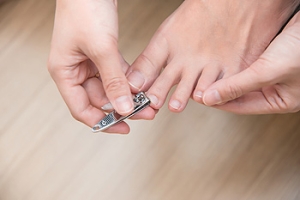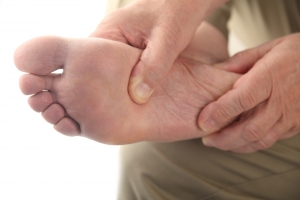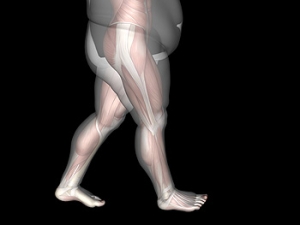
What Causes an Ingrown Toenail?
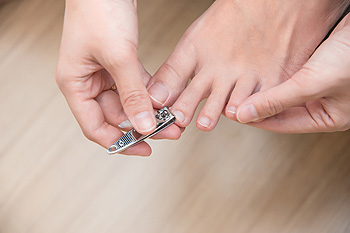 Toenails that grow into the surrounding skin of the nail bed are referred to as ingrown toenails. This foot condition is known to be incredibly painful and can cause redness and swelling to the toe. In severe cases, some patients may experience a discharge coming from the impacted toe, which is often indicative of an infection. There are several different reasons why an ingrown toenail may develop. Common causes for an ingrown toenail may include tightly fitted footwear, injury to the toe, improper toenail trimming, unusual toenail curvature, and genetic factors. If you believe you have developed an ingrown toenail, it is suggested you speak with a podiatrist to determine the best plan of treatment for you.
Toenails that grow into the surrounding skin of the nail bed are referred to as ingrown toenails. This foot condition is known to be incredibly painful and can cause redness and swelling to the toe. In severe cases, some patients may experience a discharge coming from the impacted toe, which is often indicative of an infection. There are several different reasons why an ingrown toenail may develop. Common causes for an ingrown toenail may include tightly fitted footwear, injury to the toe, improper toenail trimming, unusual toenail curvature, and genetic factors. If you believe you have developed an ingrown toenail, it is suggested you speak with a podiatrist to determine the best plan of treatment for you.
Ingrown toenails may initially present themselves as a minor discomfort, but they may progress into an infection in the skin without proper treatment. For more information about ingrown toenails, contact Joseph D. Ruffo, DPM, PC of New York. Our doctor can provide the care you need to keep you pain-free and on your feet.
Ingrown Toenails
Ingrown toenails are caused when the corner or side of a toenail grows into the soft flesh surrounding it. They often result in redness, swelling, pain, and in some cases, infection. This condition typically affects the big toe and may recur if it is not treated properly.
Causes
- Improper toenail trimming
- Genetics
- Improper shoe fitting
- Injury from pedicures or nail picking
- Abnormal gait
- Poor hygiene
You are more likely to develop an ingrown toenail if you are obese, have diabetes, arthritis, or have any fungal infection in your nails. Additionally, people who have foot or toe deformities are at a higher risk of developing an ingrown toenail.
Symptoms
Some symptoms of ingrown toenails are redness, swelling, and pain. In rare cases, there may be a yellowish drainage coming from the nail.
Treatment
Ignoring an ingrown toenail can have serious complications. Infections of the nail border can progress to a deeper soft-tissue infection, which can then turn into a bone infection. You should always speak with your podiatrist if you suspect you have an ingrown toenail, especially if you have diabetes or poor circulation.
If you have any questions, please feel free to contact one of our offices located in Sea Cliff and Babylon, NY . We offer the newest diagnostic and treatment technologies for all your foot care needs.
Ingrown Toenail Care
An ingrown toenail is a nail that has curved downward and grows into the skin. This typically occurs at the nail borders, or the sides of the nail. As a result, pain, redness, swelling, and warmth may occur in the toe. If a break in the skin forms due to the ingrown nail, bacteria may enter and cause an infection in the area; this is typically characterized by a foul odor and drainage.
Ingrown toenails have multiple reasons for developing. In many instances, the condition is a result of genetics and is inherited. The most common cause, however, is improper trimming; cutting the toenails too short forces the skin beside the nail to fold over. An ingrown toenail can also develop due to trauma, such as stubbing the toe, having an object fall on the toe, or participating in activities that involve repeated kicking or running. Wearing shoes that are too tight or too short can also cause ingrown toenails.
Treatment for an ingrown toenail varies between patients and the severity of the condition. Milder cases that don’t involve infection or other medical conditions can benefit from soaking the feet in room-temperature water and gently massaging the side of the nail. In most cases, however, it is best to see your podiatrist for thorough and proper treatment. After examining your toe, your podiatrist may prescribe oral antibiotics to clear the infection if one is present. Surgical removal of either a portion of the nail or the entire nail may also be considered. In some cases, complete removal or destruction of the nail root may be required. Most patients who undergo nail surgery experience minimal pain afterward and can return to normal activity the following day.
Ingrown toenails can be prevented with proper nail trimming and by avoiding improper-fitting shoes. When cutting the toenails, be sure that you are cutting in a straight line and avoid cutting them too short. Shoes should not be too short or tight in the toe box.
Several Forms of Foot Pain
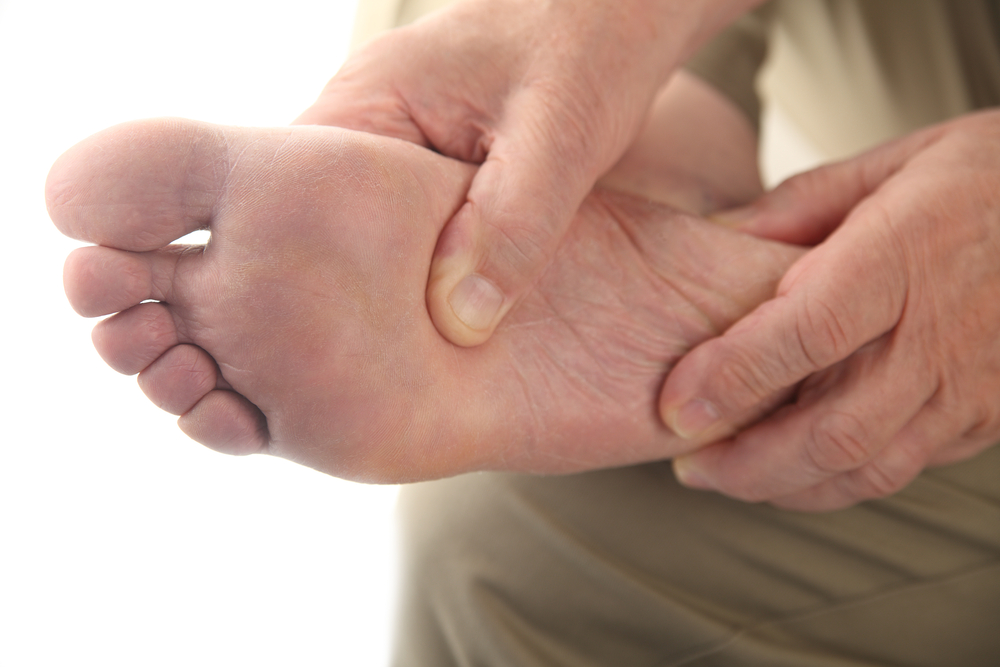 Different types of foot pain can be a common ailment among the general population. The feet are considered to be the foundation of the body, thus may be prone to injuries. Additionally, foot pain may occur from wearing shoes that do not fit correctly. The condition that is referred to as plantar fasciitis can cause severe pain and discomfort in the heel and bottom of the foot. The plantar fascia is a band of tissue that connects the heel to the toes. It may become damaged or inflamed as a result of standing on hard surfaces for the majority of the day. Additional forms of foot pain can include heel spurs, stress fractures, and bursitis. A heel spur may have similar symptoms to plantar fasciitis, and may be difficult to diagnose. If you are experiencing any form of foot pain, it is strongly suggested that you schedule a consultation with a podiatrist as quickly as possible who can guide you toward relieving foot pain.
Different types of foot pain can be a common ailment among the general population. The feet are considered to be the foundation of the body, thus may be prone to injuries. Additionally, foot pain may occur from wearing shoes that do not fit correctly. The condition that is referred to as plantar fasciitis can cause severe pain and discomfort in the heel and bottom of the foot. The plantar fascia is a band of tissue that connects the heel to the toes. It may become damaged or inflamed as a result of standing on hard surfaces for the majority of the day. Additional forms of foot pain can include heel spurs, stress fractures, and bursitis. A heel spur may have similar symptoms to plantar fasciitis, and may be difficult to diagnose. If you are experiencing any form of foot pain, it is strongly suggested that you schedule a consultation with a podiatrist as quickly as possible who can guide you toward relieving foot pain.
Foot Pain
Foot pain can be extremely painful and debilitating. If you have a foot pain, consult with Joseph D. Ruffo, DPM, PC from New York. Our doctor will assess your condition and provide you with quality foot and ankle treatment.
Causes
Foot pain is a very broad condition that could be caused by one or more ailments. The most common include:
- Bunions
- Hammertoes
- Plantar Fasciitis
- Bone Spurs
- Corns
- Tarsal Tunnel Syndrome
- Ingrown Toenails
- Arthritis (such as Gout, Rheumatoid, and Osteoarthritis)
- Flat Feet
- Injury (from stress fractures, broken toe, foot, ankle, Achilles tendon ruptures, and sprains)
- And more
Diagnosis
To figure out the cause of foot pain, podiatrists utilize several different methods. This can range from simple visual inspections and sensation tests to X-rays and MRI scans. Prior medical history, family medical history, and any recent physical traumatic events will all be taken into consideration for a proper diagnosis.
Treatment
Treatment depends upon the cause of the foot pain. Whether it is resting, staying off the foot, or having surgery; podiatrists have a number of treatment options available for foot pain.
If you have any questions, please feel free to contact one of our offices located in Sea Cliff and Babylon, NY . We offer the newest diagnostic and treatment technologies for all your foot care needs.
Foot Pain
The feet, being the foundation of the body, carry all of the body’s weight and are therefore prone to experiencing pain and discomfort. If you are experiencing foot pain, it is important to determine where in the foot you are experiencing this pain to help discover the cause of it. While pain can be experienced virtually anywhere in the foot, the most common sites of foot pain are in the heel and ankle.
Heel pain can be due to a multitude of conditions including plantar fasciitis, Achilles tendinitis, and heel spurs. Pain experienced in the ankle can be a sign of an ankle sprain, arthritis, gout, ankle instability, ankle fracture, or nerve compression. In more serious cases, pain in the foot can be a sign of improper alignment or an infection.
Foot pain can be accompanied by symptoms including redness, swelling, stiffness and warmth in the affected area. Whether the pain can be described as sharp or dull depends on the foot condition behind it. It is important to visit your local podiatrist if your foot pain and its accompanying symptoms persist and do not improve over time.
Depending on the location and condition of your foot pain, your podiatrist may prescribe certain treatments. These treatments can include but are not limited to prescription or over-the-counter drugs and medications, certain therapies, cortisone injections, or surgery.
If you are experiencing persistent foot pain, it is important to consult with your foot and ankle doctor to determine the cause and location. He or she will then prescribe the best treatment for you. While milder cases of foot pain may respond well to rest and at-home treatments, more serious cases may take some time to fully recover.
Obesity May Cause Daily Activities to Change
 Patients who are overweight can often have foot conditions that may occur as a result of being obese. The feet are considered to be the foundation of the body, and endure a large percentage of body weight. Research has indicated that for every pound of body weight, the feet absorb approximately three times the amount of force while walking. The feet and ankles may hurt while performing daily stretching routines, and this may cause exercising to cease. Additionally, larger shoes may have to be purchased to accommodate the changing size and foot shape. If you would like more information about how obesity can impact the feet, please consult with a podiatrist.
Patients who are overweight can often have foot conditions that may occur as a result of being obese. The feet are considered to be the foundation of the body, and endure a large percentage of body weight. Research has indicated that for every pound of body weight, the feet absorb approximately three times the amount of force while walking. The feet and ankles may hurt while performing daily stretching routines, and this may cause exercising to cease. Additionally, larger shoes may have to be purchased to accommodate the changing size and foot shape. If you would like more information about how obesity can impact the feet, please consult with a podiatrist.
The more you weigh, the harder your feet must work to support your body. If you’re an obese individual and are concerned about your feet, contact Joseph D. Ruffo, DPM, PC from New York. Our doctor can provide the care you need to keep you pain-free and on your feet.
Obesity and Your Feet
People who are overweight are putting more pressure on their ankles, knees, and hips as well as their feet. This unfortunately can lead to variety of different issues.
Problems & Complications Stemming from Obesity
- When the body is overweight, it tries to compensate by changing the way that it moves. An obese person may lean forward and put extra weight on the wrong part of the foot. This puts unnecessary stress on the feet.
- Obese people are also more likely to develop type II diabetes which is a condition that causes a lot of foot problems. People with diabetes often don’t feel the cuts and sores that they may have on their feet, which can lead to more complicated and severe issues.
- Plantar fasciitis is another foot condition that can be caused by obesity. Plantar fasciitis is an inflammation of the tissue along the bottom of the foot, which causes pain and stiffness while walking and climbing stairs.
If you have any questions, please feel free to contact one of our offices located in Sea Cliff and Babylon, NY . We offer the newest diagnostic and treatment technologies for all your foot care needs.
Obesity and the Feet
Obesity is a common problem in American society. Approximately one third of the U.S. population is obese. Obesity is defined as a body mass index greater than 30. Obesity has the power to affect different aspects of the body, and one of the most common problems it causes is foot pain. There have been many studies that found a connection between an increased BMI and foot problems. A simple activity such as walking up a flight of stairs can increase pressure on the ankle by four to six times.
Being overweight causes the body to compensate for the extra weight by changing the way it moves. Consequently, people who struggle with obesity commonly have arch problems in their feet. Obesity causes the arch to break by stretching the ligaments and tendons that hold the bones in the foot together. When the arch lowers, the foot may eventually fall flat. Collapsed foot arches fail to provide adequate shock absorption which eventually leads to foot pain. Other conditions that may be caused by flat feet are pronation, plantar fasciitis, weak ankles, and shin splints.
Foot problems that are caused by obesity may be treated by wearing proper footwear. Proper shoes will allow your feet to have better circulation around the arch and ankle. Additionally, those with obesity often discover that typical heel pain remedies are not effective for them. They will find that their plantar fascia is easily injured, and it is often inflamed. The best way to treat this problem is to implement lifestyle changes. A few good ways to improve your diet are to reduce calories, fill up on fruits and veggies, and to limit sugars.
Custom foot orthotics can prevent foot problems if you’re carrying excess weight or are trying to lose weight. The purpose of orthotics is to provide shock absorption to decrease the amount of stress on the joints to prevent arthritis.
Wounds That Don't Heal Need to Be Checked
How Can I Tell If I Have a Hammertoe?
 Research has found that the second toe, next to the big toe, is most likely to develop a hammertoe if an injury occurs, along with other causes. Hammertoes typically occur due to genetic factors, ill-fitting footwear, or from arthritis. This condition is most notably recognized by the appearance of the affected toe. Like its name suggests, a hammertoe will typically point downward, in a hammer-like fashion. Hammertoes can be incredibly uncomfortable and can make completing daily tasks difficult. To help ease the pain of mild hammertoes, a professional may suggest wearing custom orthotics. For more severe cases, it may be necessary to have surgery performed in order to correct this ailment. For more advice on how to treat and correct a hammertoe, please consult with a podiatrist.
Research has found that the second toe, next to the big toe, is most likely to develop a hammertoe if an injury occurs, along with other causes. Hammertoes typically occur due to genetic factors, ill-fitting footwear, or from arthritis. This condition is most notably recognized by the appearance of the affected toe. Like its name suggests, a hammertoe will typically point downward, in a hammer-like fashion. Hammertoes can be incredibly uncomfortable and can make completing daily tasks difficult. To help ease the pain of mild hammertoes, a professional may suggest wearing custom orthotics. For more severe cases, it may be necessary to have surgery performed in order to correct this ailment. For more advice on how to treat and correct a hammertoe, please consult with a podiatrist.
Hammertoe
Hammertoes can be a painful condition to live with. For more information, contact Joseph D. Ruffo, DPM, PC from New York. Our doctor will answer any of your foot- and ankle-related questions.
Hammertoe is a foot deformity that affects the joints of the second, third, fourth, or fifth toes of your feet. It is a painful foot condition in which these toes curl and arch up, which can often lead to pain when wearing footwear.
Symptoms
- Pain in the affected toes
- Development of corns or calluses due to friction
- Inflammation
- Redness
- Contracture of the toes
Causes
Genetics – People who are genetically predisposed to hammertoe are often more susceptible
Arthritis – Because arthritis affects the joints in your toes, further deformities stemming from arthritis can occur
Trauma – Direct trauma to the toes could potentially lead to hammertoe
Ill-fitting shoes – Undue pressure on the front of the toes from ill-fitting shoes can potentially lead to the development of hammertoe
Treatment
Orthotics – Custom made inserts can be used to help relieve pressure placed on the toes and therefore relieve some of the pain associated with it
Medications – Oral medications such as anti-inflammatories or NSAIDs could be used to treat the pain and inflammation hammertoes causes. Injections of corticosteroids are also sometimes used
Surgery – In more severe cases where the hammertoes have become more rigid, foot surgery is a potential option
If you have any questions please contact one of our offices located in Sea Cliff and Babylon, NY . We offer the newest diagnostic and treatment technologies for all your foot and ankle needs.
What Are Hammertoes?
Hammertoes are painful deformities that frequently form on the second, third, or fourth toe. The condition is often caused by an issue in foot mechanics. This can be caused by the person’s specific gait or the manner in which they walk, or by shoes that do not comfortably fit the deformity. Hammertoes can be formed after wearing shoes that are too narrow or short for the foot or have excessively high heels. Shoes that are not properly sized will force the toes into a bent position for long periods of time. This can cause the muscles to shorten and toes to bend into the deformity of a hammertoe.
Hammertoe can also be caused by complications from rheumatoid arthritis, osteoarthritis, trauma to the foot, heredity, or a cerebral vascular accident. Pain and difficult mobility of the toes, deformities, calluses, and corns are all symptoms of a hammertoe.
Someone who suspects they have the symptoms of a hammertoe should consult with a physician—particularly a podiatrist. Podiatrists diagnose and treat complications of the foot and ankle. If the podiatrist discovers that the affected toes are still flexible, treatment for the hammertoe may simply involve exercise, physical therapy, and better-fitting shoes. Treatment for hammertoes typically involves controlling foot mechanics, such as walking, through the use of customized orthotics.
For more serious cases in which the toes have become inflexible and rigid, surgery may be suggested. During the operation, the toe would receive an incision to relieve pressure on the tendons. A re-alignment of the tendons may then be performed by removing small pieces of bone to straighten the toe. In some cases, the insertion of pins is needed to keep the bones in the proper position as the toe heals. The patient is usually allowed to return home on the same day as the surgery.
If surgery is performed to repair a hammertoe, following the postoperative directions of your doctor is essential. Directions may include several stretches, picking up marbles with your toes, or attempting to crumple a towel placed flat against your feet. Wear shoes that have low heels and a wide amount of toe space to maintain comfort. Closed-toe shoes and high heels should be avoided. Shoes with laces allow the wearer to adjust how fitted he or she may want the shoes to be and also allow for greater comfort. To provide adequate space for your toes, select shoes that have a minimum of one-half inch of space between the tip of your longest toe and the inside of the shoe. This will also relieve pressure on your toes and prevent future hammertoes from forming.
Other preventative measures that can be taken include going shopping for new shoes in the middle of the day. Your feet are its smallest in the morning and swell as the day progresses. Trying on and purchasing new shoes midday will give you the most reliable size. Be sure to check that the shoes you purchase are both the same size. If possible, ask the store to stretch out the shoes at its painful points to allow for optimum comfort.
Why Does the Skin on My Heels Feel Uncomfortable?
 Excessively dry skin on the heels may lead to a condition that is known as heel fissures. Heel fissures are defined as deep cracks in the skin of the heels, which can cause quite a deal of pain. There are a variety of reasons why this ailment may occur. These can include sudden weight gain, wearing shoes that have an open back, or medical conditions such as eczema or psoriasis. Patients may find relief in mild cases when the affected area is moisturized several times per day, and if a pumice stone is used to remove any dead skin. In severe cases of cracked heels, it is suggested that you meet with a podiatrist who can properly trim skin that has become thick and callused, in addition to prescribing medication that may help to heal this ailment.
Excessively dry skin on the heels may lead to a condition that is known as heel fissures. Heel fissures are defined as deep cracks in the skin of the heels, which can cause quite a deal of pain. There are a variety of reasons why this ailment may occur. These can include sudden weight gain, wearing shoes that have an open back, or medical conditions such as eczema or psoriasis. Patients may find relief in mild cases when the affected area is moisturized several times per day, and if a pumice stone is used to remove any dead skin. In severe cases of cracked heels, it is suggested that you meet with a podiatrist who can properly trim skin that has become thick and callused, in addition to prescribing medication that may help to heal this ailment.
If the skin on your feet starts to crack, you may want to see a podiatrist to find treatment. If you have any concerns, contact Joseph D. Ruffo, DPM, PC from New York. Our doctor can provide the care you need to keep you pain-free and on your feet.
Cracked Heels
It is important to moisturize your cracked heels in order to prevent pain, bleeding, and infection. The reason cracked heels form is because the skin on the foot is too dry to support the immense pressure placed on them. When the foot expands, the dry skin on the foot begins to split.
Ways to Help Heal Them
- Invest in a good foot cream
- Try Using Petroleum Jelly
- Ease up on Soaps
- Drink Plenty of Water
Ways to Prevent Cracked Heels
- Moisturize After Showering
- Skip a Shower
- Keep Shower Water Lukewarm
- Don’t Scrub Your Feet
If you are unsure how to proceed in treating cracked heels, seek guidance from a podiatrist. Your doctor will help you with any questions or information you may need.
If you have any questions, please feel free to contact one of our offices located in Sea Cliff and Babylon, NY . We offer the newest diagnostic and treatment technologies for all your foot care needs.

